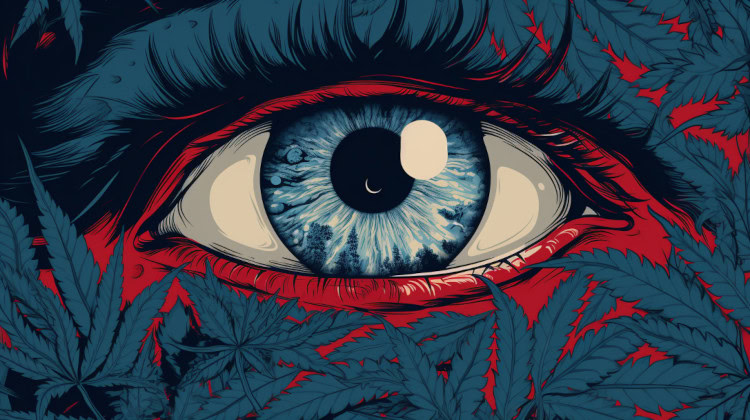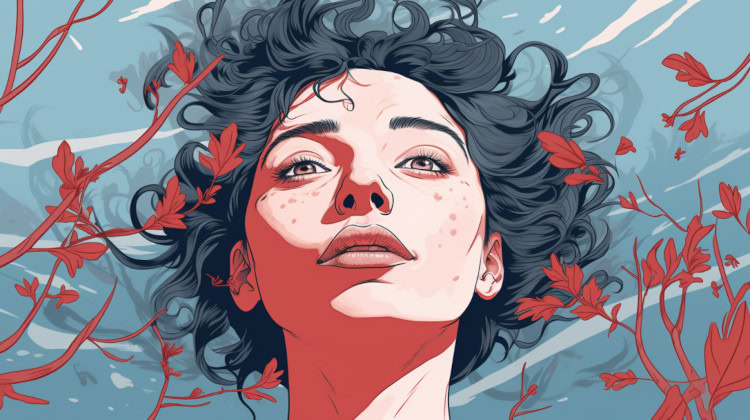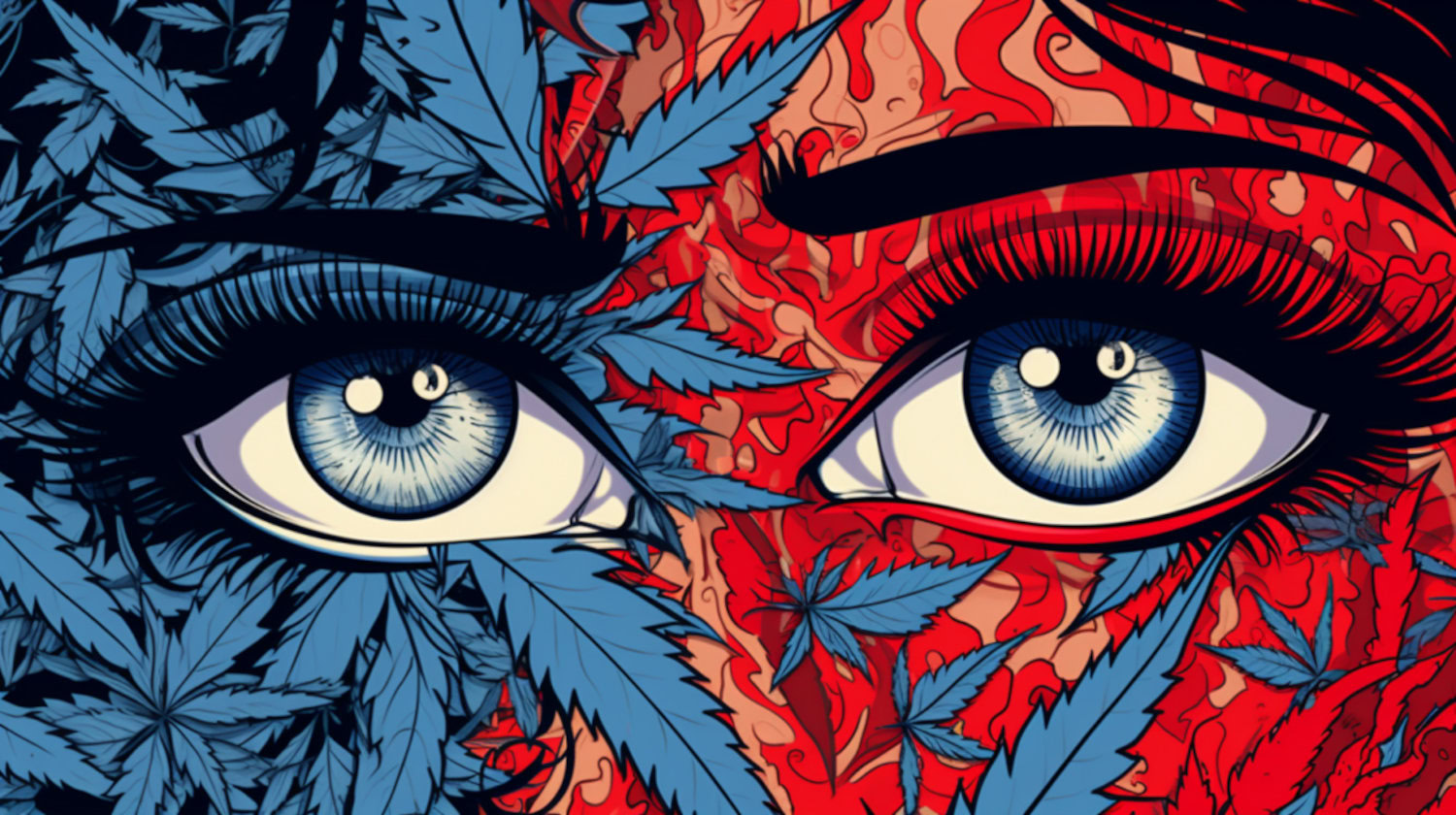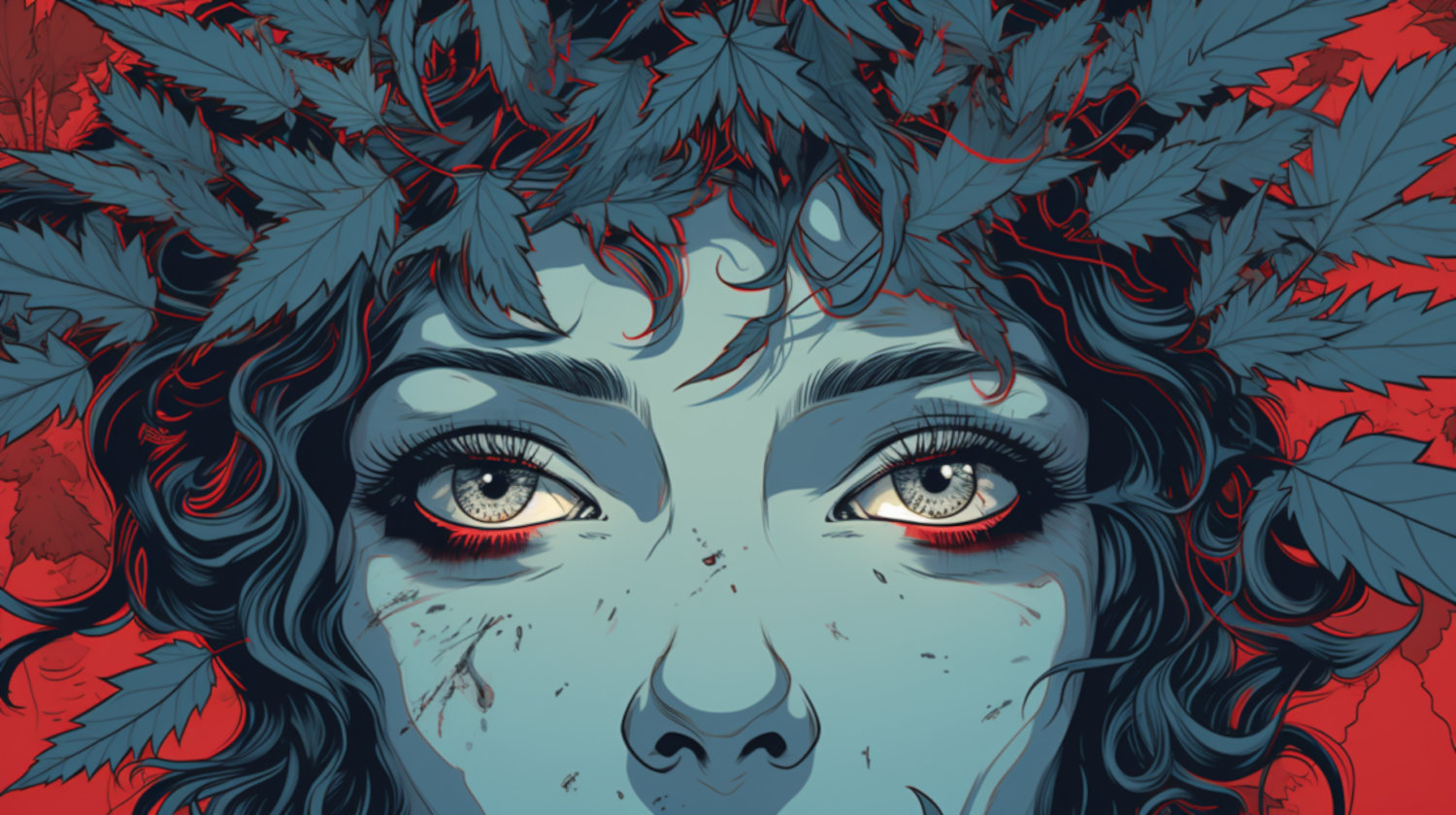Red eyes are a common adverse effect of THC consumption. When we consume cannabis, we run the risk of dilating our pupils to the point of dry redness.
We know that red eyes are a typical outcome of THC consumption, but what about other cannabinoids? Does CBD make your eyes red like THC?
Understanding Red Eyes as a Cannabis Side Effect
Red eyes appear due to dilated blood vessels in the eyes, called vasodilation, which is a side effect of THC and other cannabinoids like CBD.1,2 THC and other forms of smoked cannabis may also cause eye redness and irritation if consumed in enclosed or poorly ventilated spaces.
The severity and duration of red eyes may depend on several factors, including:
- Amount of THC consumed.
- THC tolerance.
- Age.
- Various health factors.
You can often find several remedies in the kitchen or at a local store, like:
- Eye drops.
- Cold compress.
- Caffeine.
- High-sodium foods.
Avoiding red eye isn't entirely possible if you smoke weed, but consuming low-THC potency strains may help reduce the odds.
The Difference Between CBD and THC on the Eyes

CBD and THC are the two most prevalent cannabinoids found in cannabis. While they share many similarities, they interact with the body differently. Most notable are their effects on the mind. THC is known for being intoxicating, which many might call a ‘high.’ This effect is brought on by the cannabinoid's ability to attach itself to various receptors found throughout the body and mind.
CBD doesn’t have the same binding effect on the receptors as THC does. Instead, CBD inhibits fatty acid amide hydrolase, a critical enzyme in the body, which indirectly increases the production of anandamide. Instead of creating an intoxicating effect, CBD is seen as an antagonist of THC when it's bound to the receptors. CBD may even decrease the effect and potency of THC.3,4 However, it largely depends on when you consume THC, and whether you consume CBD before, during, or after the session.
Research demonstrates that THC and CBD have vasodilatory properties. Simply put, both compounds may increase the odds of experiencing red eyes.1,2 High-THC consumers may notice red eyes more because the common method is smoking, while CBD is usually ingested.
In addition to the differences in receptor binding that THC and CBD have, they also demonstrate differences in efficacy for medical cannabis consumers. In the case of CBD, the isolated compound produces a biphasic response, which means it reaches its peak at lower doses and becomes less effective over time or at higher doses. However, the research shows that when accompanied by other cannabinoids like THC, this response does not happen, and CBD at any dose becomes more effective.5
CBD Side Effects on the Eyes
Some research concludes that CBD could interfere with intraocular pressure (IOP), leading to potential side effects for people with specific conditions, such as glaucoma.
THC is known to reduce IOP, but when CBD is introduced, IOP could elevate, leading to potential discomfort for a glaucoma patient.6 Additional research is needed to assess these findings.
While there has been some concern about CBD's impact on glaucoma patients, other studies have explored the therapeutic benefits of the cannabinoid's impact on that very condition, along with diabetic retinopathy and corneal injuries. Additional research is required before any definitive statements are made.7
Does CBD Make Your Eyes Red? There are Reasons it Might

Because both CBD and THC are vasodilators, they may cause red eyes. Two instances of consuming CBD may further increase your odds.
- Smoke: Smoke can irritate the eyes, leading to dryness and redness. CBD flower smokers may find themselves at risk of developing red eyes if they smoke in an enclosed space with little to no ventilation.8
- Allergy: While rare, people can develop an allergy to cannabis. Cannabis allergy symptoms include eye inflammation, nasal congestion, coughing, wheezing, and sneezing.9 Consult your doctor or a trusted medical professional if you have concerns about CBD allergies.
Ways to Treat and Prevent Red Eyes

Red eyes are an unwelcome, albeit short-term, adverse effect of using cannabis, especially high-potency THC strains. Thankfully, there are several options to treat or reduce red eye symptoms.
Consider these tips and best practices to minimize blood vessel dilation and the red eyes commonly associated with cannabis consumption.
- Avoid Smoking. Smoking produces irritants that can cause eye pain, discomfort, and redness when consumed in poorly ventilated areas.
- Or, Smoke in Well-Ventilated Areas. If you insist on smoking, consider doing it outside or in a location where the air can circulate.
- Stay Hydrated. Dehydration can also cause dryness, which might lead to red eyes. So whether you're getting stoned, consuming CBD, or just living your life otherwise, it’s important to stay hydrated.
- Avoid Terpenes like Limonene. Terpenes are plant compounds that affect a strain's aroma, flavor, and effects. Like THC and CBD, researchers suggest that the terpene limonene causes vasodilation. In turn, this could increase the chances of red eyes or other adverse symptoms.10
- Use Eye Drops (But Not CBD Drops). Over-the-counter and some prescription medications are made for relieving dry, red eyes. Use one of these as long as you don't have any other medical conflicts. Consult a doctor if you have any medical concerns. Avoid CBD- or any cannabis-infused eye drops, as these items can exacerbate symptoms.
- Choose Reputable CBD Products. When buying CBD or any other product, be sure to purchase regulated, lab-tested products that provide lab results that verify their contents. Do yourself a favor and read reviews as well. Consult anyone you know who's tried CBD or a specific product before buying. Online reviews can be helpful, too.
References
- Richter JS, Quenardelle V, Rouyer O, et al. A Systematic Review of the Complex Effects of Cannabinoids on Cerebral and Peripheral Circulation in Animal Models. Front Physiol. 2018;9:622. Published 2018 May 29. doi:10.3389/fphys.2018.00622 ↩︎
- Baranowska-Kuczko M, Kozłowska H, Kloza M, et al. Vasodilatory effects of cannabidiol in human pulmonary and rat small mesenteric arteries: modification by hypertension and the potential pharmacological opportunities. J Hypertens. 2020;38(5):896-911. doi:10.1097/HJH.0000000000002333 ↩︎
- Martin-Santos R, Crippa JA, Batalla A, et al. Acute effects of a single, oral dose of d9-tetrahydrocannabinol (THC) and cannabidiol (CBD) administration in healthy volunteers. Current pharmaceutical design. 2012;18(32):4966-4979. doi:https://doi.org/10.2174/138161212802884780 ↩︎
- Cather JC, Cather JC. Cannabidiol primer for healthcare professionals. Proc (Bayl Univ Med Cent). 2020;33(3):376-379. Published 2020 Jul 6. doi:10.1080/08998280.2020.1775437 ↩︎
- Russo EB. The Case for the Entourage Effect and Conventional Breeding of Clinical Cannabis: No “Strain,” No Gain. Frontiers in Plant Science. 2019;9. doi:https://doi.org/10.3389/fpls.2018.01969 ↩︎
- Miller S, Daily L, Leishman E, Bradshaw H, Straiker A. Δ9-Tetrahydrocannabinol and Cannabidiol Differentially Regulate Intraocular Pressure. Investigative Ophthalmology & Visual Science. 2018;59(15):5904-5904. doi:https://doi.org/10.1167/iovs.18-24838 ↩︎
- Aebersold A, Duff M, Sloan L, Song ZH. Cannabidiol Signaling in the Eye and Its Potential as an Ocular Therapeutic Agent. Cell Physiol Biochem. 2021;55(S5):1-14. doi:10.33594/000000371 ↩︎
- Spindle TR, Cone EJ, Goffi E, et al. Pharmacodynamic effects of vaporized and oral cannabidiol (CBD) and vaporized CBD-dominant cannabis in infrequent cannabis users. Drug Alcohol Depend. 2020;211:107937. doi:10.1016/j.drugalcdep.2020.107937 ↩︎
- Skypala IJ, Jeimy S, Brucker H, et al. Cannabis-related allergies: An international overview and consensus recommendations. Allergy. 2022;77(7):2038-2052. doi:10.1111/all.15237 ↩︎
- Cardoso Lima, T., Mota, M.M., Barbosa-Filho, J.M. et al. Structural relationships and vasorelaxant activity of monoterpenes. DARU J Pharm Sci. 2012;20(23) doi.org/10.1186/2008-2231-20-23 ↩︎
The information in this article and any included images or charts are for educational purposes only. This information is neither a substitute for, nor does it replace, professional legal advice or medical advice, diagnosis, or treatment. If you have any concerns or questions about laws, regulations, or your health, you should always consult with an attorney, physician or other licensed professional.




